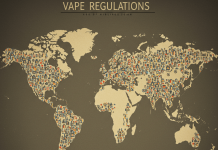Vaping has rapidly become a global phenomenon, touted as a game-changing alternative to traditional smoking.
With millions embracing e-cigarettes as a means to quit smoking or reduce harm, the conversation around vaping has grown louder—and more divided. While many celebrate its potential benefits, others raise concerns fuelled by sensational headlines and misinformation.
This polarisation often leaves people confused: Is vaping a safer choice, or does it bring new risks to the table?

Whether you’re a smoker exploring harm reduction, a vaper navigating the landscape of regulations, or simply curious about this cultural shift, this guide is your compass.
Let’s separate myth from reality and understand vaping for what it truly is—neither a miracle cure nor a villain, but a tool with risks and rewards that demand careful consideration.
Key Insights:
|
Myth-Fact Breakdown: Addressing Common Misconceptions
There’s a lot of misinformation out there about vaping, so let’s set the record straight.
Here, we break down some of the most widespread myths with facts backed by research and expert insights.
Myth: “Vaping is completely safe.”
Fact: Vaping is not risk-free but is substantially less harmful than smoking. According to the NHS, vaping reduces exposure to harmful chemicals by 95% compared to traditional cigarettes. While some harmful substances may still be present in vape aerosol, they exist at much lower levels than in tobacco smoke.
Context: This myth likely arises from a misunderstanding of harm reduction. Many public health organisations advocate vaping as a safer alternative for smokers but stress that it is not suitable for non-smokers or youth. Misinformation in the media often amplifies concerns, further muddying the waters.
Myth: “Vaping causes cancer like smoking.”
Fact: While vaping can expose users to potentially harmful substances, the levels of carcinogens are far lower than those found in cigarette smoke. Studies comparing carcinogen exposure between vapers and smokers consistently show reduced levels in vapers, pointing to its role as a harm-reduction tool.
Context: Smoking remains a leading cause of cancer because burning tobacco releases tar and other harmful carcinogens. Vaping, on the other hand, works differently—it heats a liquid to create an aerosol, completely avoiding combustion. This key difference is crucial for understanding the comparative risks between the two.
Myth: “Nicotine is the main cause of smoking-related diseases.”
Fact: Nicotine is highly addictive but is not the primary cause of smoking-related diseases. The toxic chemicals in tobacco smoke, not nicotine itself, are responsible for the vast majority of smoking-related illnesses. Nicotine can, however, have adverse effects, especially on developing brains and during pregnancy.
Context: This myth persists because nicotine is often conflated with the harmful effects of smoking. While nicotine addiction is a concern, particularly among youth, its health impacts are minor compared to the damage caused by the tar and toxicants in cigarette smoke (as supported by Cancer Research).
Youth and Vaping
The rise of vaping among teenagers has sparked significant debate and concern. While vaping is promoted as a harm-reduction tool for adult smokers, its increasing prevalence among youth has led to myths that downplay or overstate the risks.
Myth: “Most teens who vape are going to smoke.”
Fact: Research suggests that teenagers who vape are more likely to start smoking traditional cigarettes later. While not all youth vapers transition to smoking, the association between the two behaviours has been consistently documented in studies.
Context: The gateway hypothesis, which suggests vaping may lead to smoking, is a major driver of anti-vaping policies targeting youth. Addressing this issue requires a balanced approach, ensuring adult smokers can access vaping products while minimising youth exposure.
Vaping as a Quit-Smoking Tool
One of the most compelling arguments for vaping is its potential as a tool to help smokers quit traditional cigarettes. Despite its growing use in smoking cessation, misconceptions persist about its effectiveness and safety.
Myth: “Vaping isn’t effective for quitting smoking.”
Fact: Research consistently shows that vaping can be more effective than traditional nicotine replacement therapies (NRTs), such as patches or gum. A study published in the New England Journal of Medicine found that smokers who used e-cigarettes were nearly twice as likely to quit as those using NRTs. If you’re new to vaping, starting with a simple setup—like a disposable vape—can make the transition even smoother.
Context: Regulatory bodies like the UK’s National Health Service (NHS) have endorsed vaping as a harm-reduction tool for smokers. These recommendations are based on evidence showing its efficacy in reducing cigarette consumption and aiding cessation efforts.
Myth: “Vaping just leads to dual use of cigarettes and vapes.”
Fact: While some users may initially dual-use, many transition fully to vaping and eventually quit nicotine altogether. Surveys and longitudinal studies have shown that dual use often serves as a temporary phase during the quitting process.
Context: Dual use often arises due to uncertainty about vaping or a lack of access to proper guidance. Public health initiatives emphasizing vaping’s role in quitting smoking can help users make informed decisions.
Myth: “Vaping is just swapping one addiction for another.”
Fact: While vaping does involve nicotine, it eliminates the harmful tar and toxic chemicals associated with smoking. For many smokers, transitioning to vaping represents a significant improvement in health outcomes and quality of life.
Context: Critics often overlook the harm-reduction benefits of vaping, focusing solely on its addictive potential. Highlighting testimonials and success stories from former smokers can underscore vaping’s transformative impact on health.
Regulations and Misinformation
Regulations surrounding vaping vary widely across the globe, contributing to misunderstandings about the safety and accessibility of vaping products. Misconceptions about regulations often fuel debates, shaping public perception and policy.
Myth: “Vaping products are unregulated and unsafe.”
Fact: In many countries, vaping products are subject to strict regulations designed to ensure safety and quality. For instance, the UK requires e-cigarettes and e-liquids to comply with the Tobacco and Related Products Regulations (TRPR), which mandate limits on nicotine strength, child-resistant packaging, and product testing.
Context: This myth may stem from the varying levels of regulatory oversight in different regions. While some countries, like the UK, have robust regulatory frameworks, others may lack comprehensive rules, leading to inconsistencies in product safety.
Myth: “Everyone can legally buy vapes.”
Fact: Most countries enforce strict age restrictions on the sale of vaping products, typically limiting purchases to individuals aged 18 or older. Some countries, like the US, have raised the minimum age to 21.
Context: Although legal protections are in place, enforcement challenges can give the impression of widespread accessibility. Public education and better enforcement are key to addressing these gaps.
Myth: “All vaping products are the same, regardless of where they’re made.”
Fact: The quality and safety of vaping products can vary significantly based on manufacturing standards and regulations. Products made in countries with strict oversight tend to be safer and more reliable than unregulated or counterfeit alternatives.
Context: Consumers should be encouraged to purchase vaping products from reputable sources and to verify that they meet local regulatory standards.
Additional Common Myths and Realities
Even beyond the widely discussed issues, misconceptions about vaping continue to shape public opinion. Addressing these additional myths can help provide a clearer picture.
Myth: “Secondhand vapour is just as harmful as secondhand smoke.”
Fact: Studies indicate that secondhand vapour contains far fewer harmful chemicals than secondhand tobacco smoke. While it’s not completely risk-free, the levels of toxins and particulates are significantly lower.
Context: The spread of this myth often stems from concerns over public vaping and potential exposure. Public health messaging should focus on balancing caution with evidence-based risk assessments.
Myth: “Vaping is more expensive than smoking.”
Fact: While the initial cost of vaping devices can be high, long-term expenses are often lower than those associated with buying cigarettes daily. E-liquids and device maintenance typically cost less over time.
Context: This myth may arise from misunderstanding the upfront investment in vaping equipment. Clear cost comparisons can help dispel this misconception.
Myth: “E-cigarettes are likely to explode.”
Fact: Incidents of e-cigarette explosions are rare and usually caused by improper use, such as carrying around loose batteries in your pocket or failing to follow manufacturer instructions. Don’t use a mechanical mod if you don’t know what you are doing.
Context: Media coverage of rare accidents has amplified fears, but education about battery safety and proper usage can significantly reduce risks.
Myth: “All vaping devices are the same.”
Fact: There is a wide variety of vaping devices designed for different purposes, from simple disposable e-cigarettes to advanced mods with customisable settings (for example, check out the best pod vapes and best vape mods out there).
Context: Misunderstanding the diversity of vaping products can lead to confusion. Providing clear explanations and guidance can empower consumers to make informed choices.
Spotting and Addressing Misinformation
In an age where information spreads rapidly, misinformation about vaping can have far-reaching consequences. Learning how to identify and counter false claims is essential for fostering informed decision-making.
Identifying Misinformation
- Consider the Source: Check whether the information comes from a credible and unbiased organisation, such as public health agencies or peer-reviewed journals. Be cautious with claims made by anonymous social media accounts or unverified blogs.
- Look for Evidence: Reliable claims are usually supported by scientific studies or data. Misinformation often relies on anecdotal evidence or unsubstantiated opinions.
- Beware of Alarmist Language: Sensational headlines or overly dramatic language often indicate biased or misleading information.
Addressing Misinformation
- Educate with Evidence: Share accurate information from reputable sources. For example, explain how vaping reduces harm for smokers compared to traditional cigarettes, supported by research findings.
- Engage in Open Dialogue: Approach discussions about vaping with an open mind and empathetic tone. People are more likely to reconsider their beliefs when they feel respected.
- Use Social Media Wisely: Correct false claims by sharing well-sourced information. Adding links to studies or expert opinions can increase credibility.
- Support Public Health Campaigns: Amplify initiatives that focus on harm reduction and accurate education about vaping. Encourage the adoption of balanced messaging in public discourse.
By learning to recognize and address misinformation, we can contribute to a more informed public understanding of vaping and its role in harm reduction.
Conclusion and Key Takeaways
As the popularity of vaping continues to climb, it’s vital to sift through the swirling rumours and separate fact from fiction.
Although e-cigarettes aren’t free of danger, they still offer adult smokers a considerably safer way to step away from traditional tobacco.
Public opinion, muddied by confusion over health effects, teen usage, and regulatory policies, often obscures the potential role of vaping as a harm-reduction tool.
Key Takeaways
- Harm Reduction: Vaping is not risk-free but is substantially less harmful than smoking, making it a valuable tool for smokers aiming to quit.
- Youth Risks: Protecting adolescents from nicotine addiction and vaping-related risks requires robust regulations and public education.
- Efficacy in Quitting Smoking: Evidence supports vaping as a more effective quit-smoking tool compared to traditional nicotine replacement therapies.
- Regulation Matters: Regulatory frameworks play a critical role in ensuring the safety and quality of vaping products, and consumers should prioritise products from reputable sources.
- Misinformation Awareness: Recognising and countering myths with accurate, evidence-based information is essential for informed decision-making.
By clarifying what vaping really entails, we can bolster harm-reduction strategies for adult smokers without losing sight of protective measures for younger individuals.
The aim here isn’t to endorse vaping blindly but to spotlight its benefits and prevent them from getting drowned by half-truths. Armed with reliable information, people can make smarter decisions about their health and well-being.
Frequently Asked Questions (FAQ)
What is vaping?
Vaping involves inhaling an aerosol produced by an electronic device, such as an e-cigarette, which heats a liquid containing nicotine, flavourings, and other chemicals.
Is vaping safer than smoking?
Yes, studies have shown that vaping is significantly less harmful than smoking traditional cigarettes because it eliminates the combustion process that produces toxic chemicals like tar.
Can vaping help me quit smoking?
Many studies indicate that vaping can be an effective tool for quitting smoking, often outperforming traditional nicotine replacement therapies like patches and gums.
Is vaping safe for non-smokers?
No, vaping is not recommended for non-smokers, especially young people, due to the potential risks of nicotine addiction and other health concerns.
What are the risks of secondhand vapour?
Secondhand vapour contains far fewer toxic substances than cigarette smoke, but it still has trace amounts of nicotine and other chemicals.
What are the long-term effects of vaping?
The long-term effects of vaping are still being studied. While vaping is less harmful than smoking, potential risks to lung health and cardiovascular health remain areas of ongoing research.
Are flavoured vapes banned in certain countries?
Yes, many countries have implemented bans or restrictions on flavoured vaping products to limit their appeal to youth. For example, the US FDA has banned the sale of flavoured cartridge-based e-cigarettes except for tobacco and menthol flavours.





